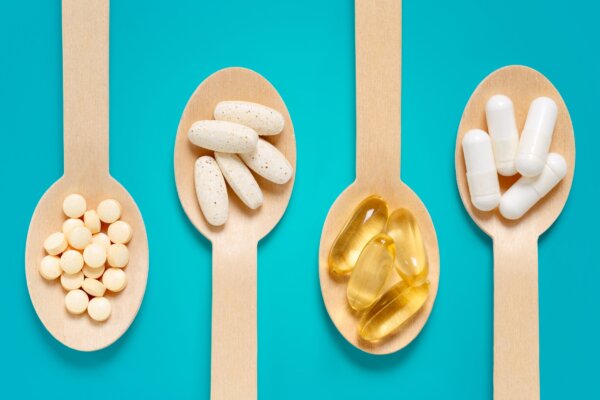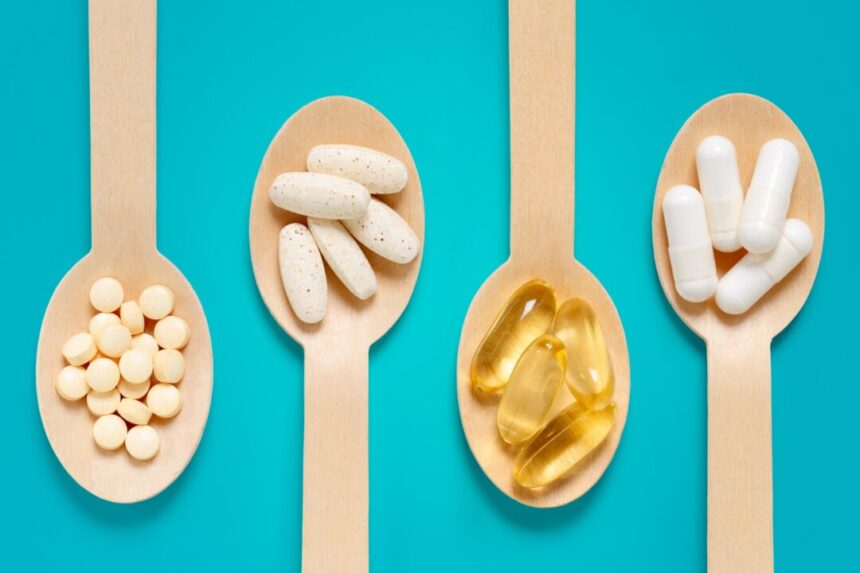
We often hear about the dangers of vitamin and mineral deficiencies, but what about taking too many?
Our hectic lifestyles can make it hard to eat well. Some people turn to vitamins, minerals, and other supplements to help pick up the slack. Supplements are supposed to give us more of what we need—but can you get too much of a good thing?
Although their prevalence may make them seem benign, some vitamins and minerals can be harmful if we overdo them, with excess levels leading to toxicity.
Let’s look at four common vitamins and minerals, why we need them, and signs that you may be getting too much.
Vitamins and Minerals
Vitamins can be either water-soluble or fat-soluble. Water-soluble vitamins include C and B vitamins (niacin, folate, thiamine, riboflavin, biotin, pantothenic acid, B6, and B12). Water-soluble vitamins are not stored in the body and are excreted via urine.
Fat-soluble vitamins, however, are stored in the body’s tissues, which means we can take too much, and in excess amounts, they can lead to toxicity. The four fat-soluble vitamins are A, D, E, and K.
Calcium and iron are essential minerals to maintain health, but too much of either can lead to serious side effects as well.
Renee Kindler is a functional medicine and nurse practitioner at Aonani Functional Medicine. When it comes to vitamins, minerals, and hormones, she told The Epoch Times it’s best to follow “the Goldilocks principle.”
“You don’t want too much or too little. Some vitamins and minerals, your body is good at eliminating extra if you have extra, and for some of them, it’s more of a challenge,” she said.
Vitamin A
Vitamin A, also known as retinol, is a fat-soluble vitamin needed for clear vision, a healthy immune system, and growth, development, and reproduction.
The recommended daily allowance, or RDA, of vitamin A we need depends on our age and gender and is measured in micrograms (mcg) of retinol activity equivalents, or RAE.
Note: Recommended daily allowances are often based on the minimum amounts needed to avoid deficiency and disease and not necessarily levels required for optimal health.
- Adult men (19 years and up)—900 mcg
- Adult women (19 years and up)—700 mcg
- Pregnant women—770 mcg
- Breastfeeding women—1,300 mcg
Too Much Vitamin A
It is possible to get too much (preformed) vitamin A, which is usually a result of taking supplements and medications. Symptoms of high preformed vitamin A include:
- Dizziness
- Nausea
- Blurred vision
- Severe headaches
- Muscle aches
- Coordination problems
In rare extreme cases, excess levels of vitamin A can cause coma and death, and there is a danger of taking too much in pregnancy.
“Vitamin A can cause birth defects, and you can’t reverse that. If somebody’s taking it for acne, a lot of times that can be a childbearing age woman. So that’s something to pay attention to,” Mrs. Kindler says.
Excessive beta-carotene intake can make the skin turn orange, However, this is harmless and can be remedied by taking less.
The NIH states that the upper limit (UL) for vitamin A from all sources is 3000 mcg for adults over 19 years. There are no upper limits for beta-carotene and other forms of provitamin A.
The authors cautioned that because preformed vitamin A is being added to many processed foods, there was an urgent need to develop population biomarkers to diagnose hypervitaminosis before toxicity.
Vitamin A can interact with certain medications. Conversely, some medications can affect the absorption of vitamin A, so speak to your prescribing physician if you are on medications and considering taking a vitamin A supplement.
Vitamin D
Vitamin D, or calciferol, is an essential nutrient we get from the foods we eat and a hormone our bodies produce. The two types of vitamin D vital to human health are vitamin D2 (ergocalciferol) and vitamin D3 (cholecalciferol).
Vitamin D2 primarily comes from plants, while our vitamin D3 comes from animal sources (about 10 percent), with the rest produced by our bodies from exposure to sunlight. Vitamin D3 is better absorbed and more potent than vitamin D2. The liver and kidneys must convert all the vitamin D2 and D3 we get from foods or supplements into the active form our bodies can use.
Vitamin D is fat-soluble and necessary for our bodies’ absorption of calcium and phosphorus, which are needed to make bones. Without calcium and vitamin D, we are more susceptible to osteoporosis, where bones become weak and are more likely to break.
Vitamin D and the Sun
Our bodies make vitamin D when our skin is exposed to sunlight. However, some things, like clouds, air pollution, old age, and having dark skin, reduce our ability to get vitamin D from sunlight. The NIH also notes that the skin doesn’t produce vitamin D from sunlight through a window.
- Birth to 12 months—10 mcg (400 IU)
- Children 1 to 13—15 mcg (600 IU)
- Teens 14 to 18—15 mcg
- Adults 19 to 70—15 mcg
- Adults 71 years and older—20 mcg (800 IU)
- Pregnant and breastfeeding women: 15 mcg
Too Much Vitamin D
Too much vitamin D can be harmful, and a blood test is the only way to measure how much vitamin D you are getting. Vitamin D deficiency is more common, with estimates that at least 25 percent of American adults are not getting enough.
- Loss of appetite
- Dehydration
- Muscle weakness
- Nausea
- Vomiting
- Confusion
- Pain
- Excess urination and thirst
- Kidney stones
Extreme levels can cause kidney failure, irregular heartbeat, and death. You can’t get too much vitamin D from the sun, as your body limits how much it produces. High levels are almost always due to supplements.
- Birth to 6 months—25 mcg (1,000 IU)
- Infants 7 to 12 months—38 mcg (1,500 IU)
- Children 1 to 3 years—63 mcg (2,500 IU)
- Children 4 to 8 years—75 mcg (3,000 IU)
- Children 9 to 18 years—100 mcg (4,000 UI)
- Adults 19 and older—100 mcg (4,000 UI)
- Pregnant and breastfeeding women—100 mcg (4000 IU)
Interactions
Vitamin D can interact with medications, including some types of weight loss drugs, statins, steroids, and thiazide diuretics. If you are taking medications, consult your prescribing physician before supplementing with vitamin D.
Calcium
Calcium is the most abundant mineral in the body, and almost all of it is found in our bones and teeth, giving them their strength and structure. We need calcium for proper muscle and nerve function. Our bodies cannot make calcium, and we lose calcium every day through our hair, nails, skin, sweat, and other excretions. We must get enough from our diet to ensure calcium isn’t being taken from our bones, which, if excessive, can lead to osteoporosis.
Dairy foods, green vegetables, fish, beans, nuts, and fruits are rich in calcium. Some foods are also fortified with calcium to help us achieve optimal levels.
Exercise, vitamins D and K, magnesium, and phosphorus help the body absorb calcium and increase bone mass. Other factors that affect calcium absorption include age, diseases (like Crohn’s and celiac), and medications.
Many forms of calcium are available in supplement form, and they differ according to their content, how well they are absorbed, and their cost. The two most common are calcium citrate and calcium carbonate.
- Adults 19 to 50—1000 milligrams (mg)
- Men 51 to 70—1000 mg
- Women 51 to 70—1200 mg
- Adults 71 and over—1200 mg
- Pregnant and breastfeeding women—1000 mg
According to the Harvard T.H. Chan School of Public Health, the UL for calcium is 2,500 mg daily from food and supplements. They also note that those over fifty shouldn’t take more than 2,000 mg of calcium daily from supplements as it can increase the risk of constipation, kidney stones, and prostate cancer.
Too Much Calcium
Too much calcium results in a condition called hypercalcemia—symptoms of which include:
- Fatigue and weakness
- Vomiting and nausea
- Shortness of breath
- Chest pain
- Heart palpitations and irregular heart rate
Mrs. Kindler also notes the potential dangers of excess calcium.
Interactions
Calcium supplements can interact or interfere with certain medications, and some reduce calcium levels in the body. If you are on medication, consult with your prescribing physician before taking calcium supplements to ensure you are doing it safely.
Iron
Iron is a mineral needed for growth and development. Iron is also an essential component required to make blood. Our bodies need it to make hemoglobin, a protein in red blood cells that helps carry oxygen throughout the body. Iron is also necessary to produce myoglobin, a protein that brings oxygen to the muscles. Iron Source link





